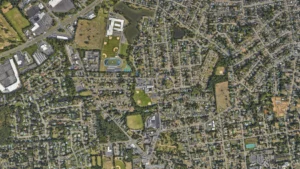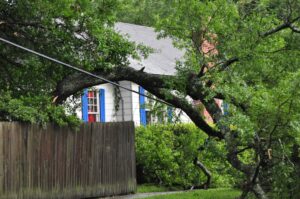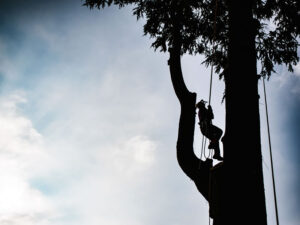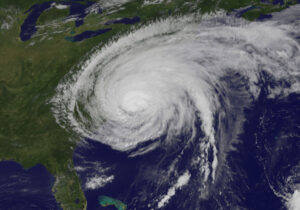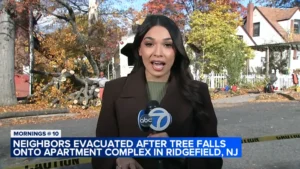In This Article ...
Certified Arborist Insight: Protecting Your Property After the Storm
Hurricane Erin did not make landfall in New Jersey, but residents across eastern Monmouth County felt its power this week. From Sandy Hook Bay through Atlantic Highlands, Sea Bright, Monmouth Beach, Long Branch, and down to Belmar, the storm’s outer bands brought flooding, rough surf, and gusty winds that tested trees in every neighborhood. As a certified arborist with more than 25 years of experience caring for local trees, I know these conditions can create hidden risks long after the skies clear.
Though Hurricane Erin tracked offshore, its size — more than 500 miles wide — meant coastal New Jersey faced tropical-storm-force effects. Towns along the oceanfront saw pounding waves, flooded streets, and salt spray carried inland by wind gusts in the 40–50 mph range.
Atlantic Highlands and Highlands dealt with tidal flooding near Sandy Hook Bay, while Sea Bright and Monmouth Beach took the brunt of storm surge on their narrow strips of land. In Long Branch and Belmar, streets near the boardwalk and marina areas briefly turned into rivers. Inland towns like Shrewsbury, Eatontown, and Ocean Township experienced fewer water issues, but gusty winds were enough to stress tree canopies and loosen already saturated root systems.
Hurricane Erin: Wind Impacts Along Eastern Monmouth County
Wind Strength and Local Impact
-
Forecast Conditions: State officials warned of sustained winds up to 50 mph with stronger gusts along the shoreline.
-
Offshore Observations: Buoys and coastal stations reported gusts exceeding 45–50 mph, especially during high tide cycles.
-
Shoreline Exposure: Communities directly on the oceanfront — Sea Bright, Monmouth Beach, Long Branch, and Belmar — saw the greatest wind stress. Open exposure and minimal natural buffers left homes and trees more vulnerable.
-
Inland Effects: Towns along Sandy Hook Bay, including Atlantic Highlands and Highlands, recorded gusty winds funneled off the bay, which can topple weakened limbs even without direct ocean exposure.
Tree and Property Risks
-
Mature Shade Trees: Large oaks, maples, and sycamores common to Monmouth County can lose major limbs under 40–50 mph gusts.
-
Clay Soil Issues: In neighborhoods like Oceanport, West Long Branch, and Eatontown, saturated clay soil increases the risk of uprooting during high winds.
-
Ornamentals and Pines: Smaller ornamentals, coastal cedars, and shore pines are prone to salt-burn and branch shear during high wind events.
What Strong Winds Do to Local Trees

Wind is one of the greatest threats to tree stability, especially in Monmouth County where soils often contain heavy clay. When roots are stressed by standing water, gusts as low as 40 mph can uproot shallow-rooted species such as maples and ornamental cherries. Even deep-rooted oaks and sycamores, common along Broad Street in Shrewsbury or Ocean Avenue in Long Branch, can suffer from branch shear or trunk cracks when winds buffet saturated wood.
In coastal towns, salt carried inland on strong winds adds another layer of stress. Pines, cedars, and ornamental evergreens often display browning tips or needle loss after exposure to salty spray. While this may not be immediately obvious, damage builds over time, leaving trees vulnerable to pests and disease.
Flooding and Soil Saturation Raise Risks

Flooding from Hurricane Erin was short-lived, but waterlogged soils linger long after tides retreat. When water sits around roots, oxygen is displaced, limiting the tree’s ability to anchor itself. That is why neighborhoods in Oceanport, West Long Branch, and Eatontown — all areas with lower elevations and clay-heavy soils — may notice trees leaning or shifting days after a storm.
A leaning tree is not always an emergency, but it is always a red flag. Once root systems are disturbed, stability rarely improves on its own. Early evaluation and corrective pruning or cabling can prevent a total collapse.
Common Post-Storm Problems We See
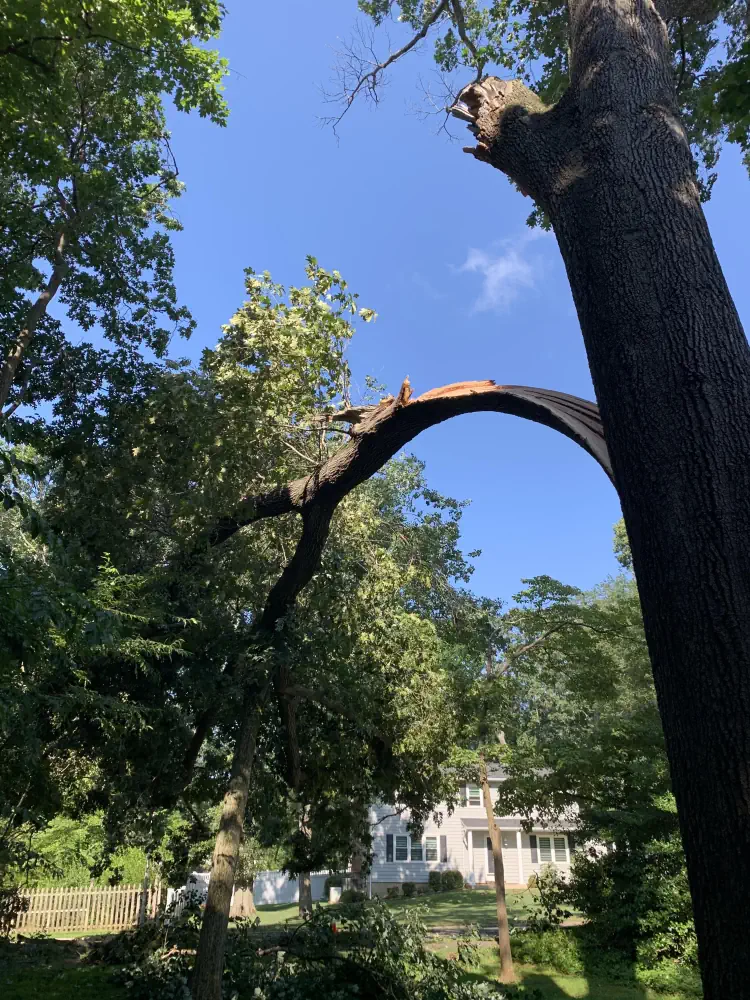
Every time a storm like Erin sweeps past the Jersey Shore, my team and I at Hufnagel Tree Service encounter the same issues across Monmouth County:
-
Hanging or broken limbs caught in canopies above driveways, sidewalks, and power lines.
-
Split crotches in older oaks and maples, often invisible from the ground until inspected closely.
-
Salt-burn damage on ornamentals and evergreens, showing as browning or curling leaves.
-
Partially uprooted trees in waterlogged soil, leaning toward structures or walkways.
-
Hidden decay exposed when winds snap weak limbs.
Each of these conditions poses a safety risk, but also an opportunity to restore trees before damage becomes irreversible.
Why Post-Storm Inspections Matter

After a storm, many homeowners focus on clearing debris from lawns or driveways. While that is important, the real danger often remains overhead. A limb that looks stable today may drop tomorrow, especially after high winds weaken its attachment. Tree inspection is not about fear — it is about prevention.
As a certified arborist, I am trained to spot stress fractures, fungal infections, and root instability that homeowners might miss. Early action can mean the difference between saving a valuable shade tree and losing it entirely. For properties in historic neighborhoods like Shrewsbury, or oceanfront estates in Deal and Monmouth Beach, that difference represents not only safety but also long-term property value.
What Homeowners Should Do Right Now
Hurricane Erin is a reminder that Monmouth County trees live with constant exposure to coastal weather. Homeowners should:
-
Walk their property and check for leaning trees, cracks, or hanging limbs.
-
Look up at canopies where broken branches may be lodged.
-
Inspect the soil line for signs of upheaval or exposed roots.
-
Note changes in foliage that suggest salt burn or wind stress.
-
Call a certified arborist before attempting to prune or remove anything dangerous.
Remember, ladders and chainsaws are not storm-response tools for homeowners. Too many injuries occur each year when property owners try to clear storm damage without professional training or equipment.
How Hufnagel Tree Service Helps
At Hufnagel Tree Service, we combine modern equipment with decades of local experience. That means we know how to treat salt-burn on coastal evergreens, how to cable large oaks without damaging their historic form, and how to prune ornamentals to recover from storm stress.
We offer:
-
Emergency storm response and safe removal of fallen limbs.
-
Risk assessments and corrective pruning to prevent future damage.
-
Canopy shaping that improves airflow and reduces wind resistance.
-
Soil care and restoration to strengthen root systems after flooding.
Our work is not just about trimming — it is about preserving the health, safety, and beauty of Monmouth County’s tree canopy.
Gain Peace of Mind With A Post-Storm Inspection By Certified Arborists

From Sandy Hook Bay and Atlantic Highlands to Long Branch and Belmar, Hurricane Erin showed how quickly wind and water can put stress on Monmouth County’s trees. Many residents will see the effects in the weeks ahead, from leaning trunks to browning leaves. The good news is that with prompt, professional care, most trees can recover and continue to provide shade, beauty, and value for years to come.
If you suspect your trees were damaged during Erin or want to prepare for the next storm, call Hufnagel Tree Service today. With more than 25 years of certified arborist experience in Monmouth County, we are here to keep your property safe and your trees healthy.
Schedule Service
From precision pruning and safe removals to health assessments and preventative care, Hufnagel Tree Service delivers expert solutions backed by decades of experience. We offer certified insight, fair pricing, and a commitment to doing what’s best for your landscape.
Take Advantage of These Special Offers:
10% OFF
Tree Service Over $100
15% OFF
Tree Service Over $250
20% OFF
Tree Service Over $500
Learn More About Our Services
Related Articles

Keep Trick-or-Treaters Safe: A Halloween Tree Safety Guide
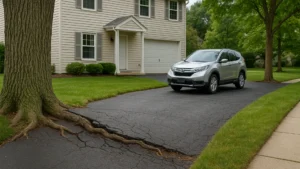
Tree Roots & Foundation Damage: What Homeowners Should Know
